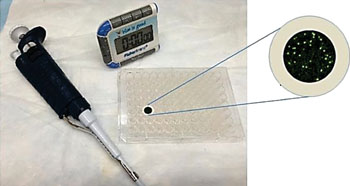New Method Determines Efficacy of Immune Cells
By LabMedica International staff writers
Posted on 09 Nov 2016
The frequency of pathogen-specific and tumor-specific T cells and their functional activity reflect the effectiveness of immune responses and can serve as useful diagnostic and prognostic indicators.Posted on 09 Nov 2016
The immune system orchestrates large and small scale attacks on innumerous targets: viruses, bacteria, cancer, but it also misfires causing allergy or autoimmune reactions. Compounding the problem, not every immune reaction is equal, sometimes a necessary reaction is not strong enough or at times it is too strong.

Image: Detail of a CaFlux plate and the green fluorescent read-out from activated immune cells (Photo courtesy of Thomas Jefferson University).
A team of scientists at Thomas Jefferson University (Philadelphia, PA, USA) has developed a new way to determine the strength of an immune response to a particular antigen. The test works by attaching immune cells that can both respond to as well as display potential immune targets, and then flowing potential antigens over the immune cells to look for "matches." If the addition of antigen leads to a match between displayer and responder, the two cells attach to each other with their receptors. That attachment triggers calcium channels to open, which then activates a green fluorescence in the cells. The green light can be easily detected by microscope and quantified by image-reading software.
The test called the CaFlux assay can help see both how many T-cells respond in a given sample, as well as how powerfully and how rapidly each individual cell responds over time. These three pieces of information could more accurately predict how a person would react to a wide array of immune threats, from viral or bacterial attacks to allergens. The test could be useful in developing better vaccines, assessing the potency of immunotherapy interventions, and understanding the severity of disease, and therefore the appropriate level of medical intervention. Magnetic sorting of T-cell subsets, the CD8 T cells were purified from frozen human peripheral blood mononuclear cells (PBMC) by negative selection using MACS Cell Separation Technology (Miltenyi Biotec, Bergisch Gladbach, Germany).
The team tested T-cells from a bone marrow transplant recipient for reactivity to cytomegalovirus (CMV). Most people harbor CMV, but the infection is usually kept in check by a healthy immune system. They tested the new T cells after the transplant, the patient’s cells showed a slow and weak response to the same antigens, or CMV targets. Neal Flomenberg, MD, a professor of Medical Oncology, and a co-author of the study, said, “That weak response was mirrored by what happened in the clinic. The patient's CMV reactivated while the immune system was still rebooting and unable to mount a strong response against CMV, and he had to be treated for the infection. Had we been able to monitor this patient's immune system's ability to respond to CMV, we may have been able to tailor his treatment to better keep the CMV in check.” The study was published on October 27, 2016, in the journal Nature Communications.
Related Links:
Thomas Jefferson University
Miltenyi Biotec










 (3) (1).png)



